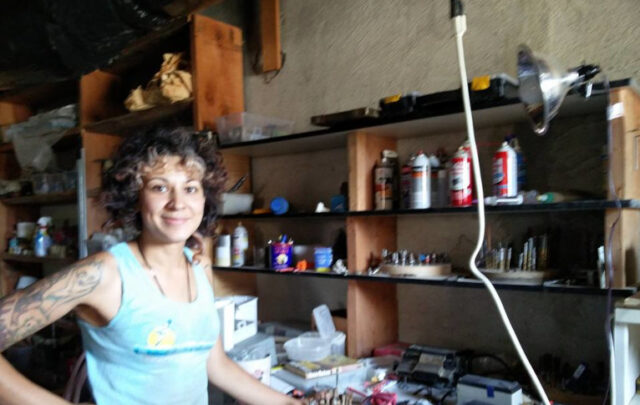In November and December of 2015, I visited a couple of places in India that inspired some questions and thoughts about what is involved in protecting the earth. I was particularly impressed with what a difference the qualities of individual human beings can make, as well as the qualities of their relationships and affiliations with others. Equally interesting are the contributions of specific cultural foundations.

While staying at a monastery in northern India, I passed by a hillside retaining wall on which someone had painted the words, “Protect the earth. Live simply. Act with compassion. Our future depends on it.” I was surprised by the strong impression that this graffito made on me. We are surrounded by demands from ads that plead with us to do something or other. But somehow, these three simple imperatives seemed especially compelling. They bring together everything, really, that ought to be done.
We can protect the place we live by choosing to live simply, sustaining awareness of all life. These words also reflect the larger context of a meaningful life on earth, free of small-minded compulsions. Paring down materially frees up some of our attention, allowing us to recognize the people and living beings around us. By living simply, we show compassion for others; by acting compassionately, we reduce the insecurity, loneliness, neglect and mistrust that lead us to prioritize our own comfort over the needs of others. By building trust, we create opportunities for joy.
Not quite your average graffiti, these words quote the head of a Buddhist order, the 17th Karmapa of the Kagyu lineage of Tibetan Buddhism. Alarmed by the prospect of disappearing glaciers, rivers and forests in the Himalayas and Tibet, he has taken on the role of environmentalist leader, Tibetan Buddhist style. Under his leadership, all of the monasteries in his order have changed their resource-use practices, and become environmentalist educators in their communities. Representatives from the order meet regularly at conferences with environmental activists and scientists, to work out principles, guidelines and activities. Though the situation is changing, monasteries were traditionally held in high regard as standard-bearers and educators, much as some churches and cathedrals were, at one time, in parts of Europe. Their influence remains substantial, especially among Buddhists, and so these religious leaders have been able to help raise the general level of awareness of the need for everyday people to make sustainable choices.
One of the things that is interested me most about this, as an American observer, was that they articulate this appeal to protect the earth in terms of the preciousness of life (rather than in terms of objective measures like CO2 levels), and advocate mindfulness of all living beings on everyone’s part in daily choices (rather than government policies). I’m not implying that CO2 levels and government policies are unimportant. Rather, I’m wondering about what kinds of things really motivate us — how we can be inspired to join with others to really change our practices.
We are used to being told that we are fundamentally selfish beings, that you have to appeal to self-interest, that it is important to ‘look out for Number 1,’ and so on. Some may be convinced by this axiom of folk wisdom, but some are not. I find the idea of spending my life trying to get ahead of everyone else kind of bleak — and I know I’m not alone in this.
I find the Karmapa’s words to be motivating in a way that these modern appeals to a self-interested way of life fail to be, because they connect protecting the earth with meaningful living through compassionate action and living simply. Whether you call this kind of motivation ‘spiritual’ or not (some are allergic to the word) it is definitely one that moves us in a liberating direction, out of the confines of self-absorption into a greater capacity to enjoy what already we have, like our relationships with other living beings.

The work of saving the world has always been largely about changing our culture. Culture is our shared art of understanding and doing things, our shared treasury of practices of thought and action. Humanity has never stopped changing its cultures, adapting practices to new realities and new challenges. But if the proposed changes do not reflect our actual motives and our true nature, we will do something else instead. Can ‘live simply’ possibly reflect our actual motivation? I think so — but only if we work out practices of simplicity that open up new joys and freedoms, not just the experience of simple deprivation. They have to be practices that a lot of people are willing to adopt at the same time.
To a visitor from the West, living simply seems to come more easily in rural India than it does at home. It starts with the fact that everyone else around you is living much more simply (in the material sense of using fewer resources). It’s warm a lot of the time in many parts of India, so central heating and hot water are mostly unnecessary. ‘Cold’ showers aren’t that bad when it’s hot, and the water isn’t very cold. Some people in colder areas place water tanks in the sun, so that there is hot water in the afternoon and evening. Drinking water is kept cool by evaporation in terra cotta vessels. Fresh, local dairy and produce is supplied daily, so refrigeration isn’t essential. If you put more food on your plate than you can eat, the rest is fed along with other scraps to the animals. Animals turn this food into dung, which becomes fuel or fertilizer. Firewood is gathered from the prunings of trees that may also serve other functions – air conditioning (shade), fodder, medicine, fruit, and soap. Materials for houses and other buildings, such as stones, lime, clay for bricks, bamboo for struts, and grass for thatch, are quarried or grown locally. Traditional building techniques are adapted to the climate, keeping houses cool even in the scorching sun. Laundry is picked up and returned by someone whose family business is to handwash clothes under a handpump. All of the necessary functions are handled by someone somewhere in the local area.

Living this simply and sustainably is more difficult to imagine here.
Increasingly, the traditional Indian village and its materially simple livelihoods are also hard to imagine for the urban Indian ‘middle class’ (really the top 10-20%). The urban affluent have abandoned traditional artisanal goods and local market relationships in favor of imported luxury goods and global market systems. Even in the villages, farmers, artisans and service providers are being put out of business by the effects of global markets on prices, and moving to the cities. Artisanal food and goods are replaced by mass-produced packaged goods that, though not cheaper for the consumer, ‘save’ the vendors on labor. For the first time, there is waste; cans and plastic wrappers are piling up in the streets. Ourselves having already abandoned locally self-sustaining production generations ago (as we now begin to reconsider their value), it is disquieting to witness this apparent devolution of community self-reliance.
An Indian might find this disquiet a hypocritical reaction: why should the comforts that we Americans enjoy not be available to everyone? But it seems to me that that is precisely what we ought to do: consider everyone. None of us should be trying to accumulate more and more while others are in need. The market system that the world has lately adopted is inherently exclusive, dependent on moving huge amounts of capital around, sometimes in a way that amounts to gambling with people’s livelihoods. For most economic refugees arriving from the countryside, the opportunities that the city seems to offer are largely a mirage. The loss of the mutual interdependence of the village, imperfect though it is, is an awfully high price to pay for these illusions. It is also true, though, that it is difficult for the villages to continue maintaining the delicate balance of local self-reliance and interdependence, especially as India pursues the ‘growth’ promised by globalization.

After a month in north India, I headed a thousand miles south, to visit a nonprofit collective organization working with people in a drought-prone region. The collective was founded in 1990 by a couple, with the support of friends and their networks of sustainable development activists and specialists. It started as an endeavor to coax life into returning to a deforested, eroded and calcified valley. The whole region had once been thickly forested, up to around a century ago. Over time, traditional water and land management systems had been disrupted, partly due to colonial rule, and the ensuing loss of the forest changed the climate. Pockets of land slipped into desert. The valley was designated a wasteland. Farmers in the surrounding region committed suicide, as the model of commercial agriculture lately promoted by the government (under corporate influence) failed.
Timbaktu Collective’s work over the last 25 years provides a rare window into how much can be achieved by staying close to a few simple but fundamental principles of life, such as trust in people’s wisdom, mutual cooperation, and the resilience of living beings. The collective’s logo includes the line, ‘Life, we celebrate you.’
This celebration of life and faith in people manifests in many ways: a rich but materially simple way of living, an expansive and varied range of friendships, working groups, cooperative businesses, women’s thrift societies and activist networks, as well as projects to restore desertified lands, recover traditional water management and farming methods, and support the marketing of organic produce. As another visitor remarked, the days actually do seem to unfold as an ongoing celebration of life. This is remarkable, because the place is not an ashram or retreat center, but a working community of sustainable development activists, who work long hours confronting harsh realities in the physical, natural, political and economic environments. Celebration frequently takes the form of gatherings and festivals, but more fundamentally in the subtler yet more sustaining form of sharing the work and its fruits.

This faith in people and life, and the intention to make it possible for everyone to live joyfully, has been the foundation of the collective’s strategy. Solutions are not imposed: they are home-grown by the people themselves, with the support of organizational help, to suit the circumstances.
Over the years, as the root stresses on the local human and natural environment become evident, the collective has responded by starting new collectives and working community groups (or sanghams) to address needs. For example, over sixteen hundred organic farmers in 45 villages have joined to share knowledge, seeds, and other resources in dozens of local cooperatives. Marketing cooperatives have been started to manage the financing and marketing of crops, reducing local dependence on moneylenders and middlemen. Though it doesn’t always increase the size of the harvest, organic farming is also more economical, without the need for patented seeds and chemicals. So the incomes of farmers taking up organic farming have increased and, just as importantly, stabilized.
Another major positive influence on community self-reliance has come from twenty thousand women in the surrounding region, who are contributing members of four thrift societies which collectively manage assets that can be invested in family and community enterprise. In addition, people with disabilities in dozens of villages have started self-help sanghams, working out ways for families and communities to help disabled children and adults develop their talents, and to construct helpful tools and devices. Finally, even children contribute, in the form of children’s sanghams that advocate for children’s rights and needs.
In my short visits there, I have tried to understand how it is possible to hold things together, and get anything done, in such a democratic, non-technocratic way. Partly it is rooted in the heritage of Indian civilization. This includes a uniquely Indian practice of local and regional democratic self-rule or ‘swaraj,’ which has emerged, disappeared and re-emerged as empires have risen and fallen. Since India’s independence from the British in 1947, village swaraj has been established as law, with mixed degrees of success. One of the most striking manifestations of this tradition is the awe-inspiring stamina that people have for hashing things out in meetings, which can last for days. When the issues are complicated, they are taken apart and handled piece by piece, until each piece is settled. Based on mutually accepted ground rules of effective discussion, people wait their turn and hear everyone out. There seems to be a common recognition that participation in shaping the conditions in which we live is worth doing, and worth doing well, even though it can be time-consuming and frustrating. To someone from a nation that claims to be a leader in democratic practice, seeing this level of democratic engagement was rather humbling.
Another aspect of Indian civilization is its vaunted ‘fatalism,’ which could also be seen as its patience with impermanence and the laws of cause and effect, its respect for wisdom, and its openness to that which is larger than oneself. Impulsiveness, thoughtlessness, paranoia and other side-effects of self-absorption are more seldom seen, and so don’t get in the way as often.
Partly it’s that the individuals involved are very special people, or have become unusually powerful (in the good sense) as a result of the way they work with others. Each one of them is one in a hundred million. Mutual respect between members and leaders is very strong, which holds the ship together in troubled waters.
The collective’s way of working could be described as bringing together place-based self-reliance with a network-based strategy. The place and its people are the fundamental resource. The land, when attended to, can be relied upon to come to life. The people, when listened to (and who listen to each other), can find solutions and meet each other’s needs. Strategy – the formation of new groups and initiatives – are conceived in friendships and other relationships of trust, which extend widely. The variety of people in these networks — including numerous intellectuals, agricultural scientists, business professionals, and even officials — allows for rich cross-fertilization in the laboratory of this specific place and people. Once this kind of foundation in the land and the people is laid, finding motivated support, including project financing, is more likely to succeed.
Returning to the United States, I’m wondering what cultural, social or political resources we have, especially at the local level, that can help us to see ourselves as part of a common effort to ensure everyone is taken care of. I’ve seen and heard of towns and small cities that have strong social service networks, engaged congregations, and municipal leaders who pay attention to quality of life and stresses in the community. I still think we could do a better job of spreading the spirit of openness and compassion, of taking more responsibility for the conditions we live in, and of building our stamina for participation and engagement. Only through building some trust and confidence in each other, sharing burdens, and making sure that all our needs are met, will we truly find the motivation to protect the earth.





